
Ancient Greek technology
Encyclopedia
Ancient Greek technology developed at an unprecedented speed during the 5th century BC, continuing up to and including the Roman period, and beyond. Inventions that are credited to the ancient Greeks such as the gear, screw, rotary mills, screw press, bronze
casting techniques, water clock, water organ, torsion catapult and the use of steam to operate some experimental machines and toys and a chart to find prime numbers. Many of these inventions occurred late in the Greek period, often inspired by the need to improve weapons and tactics in war. However, peaceful uses are shown by their early development of the watermill
, a device which pointed to further exploitation on a large scale under the Romans. They developed surveying
and mathematics
to an advanced state, and many of their technical advances were published by philosophers like Archimedes
and Hero
.
s for water supply, storm water and wastewater sewerage systems, flood protection and drainage, construction and use of fountain
s, baths and other sanitary and purgatory facilities, and even recreational uses of water.
mines at Laurium
, the profits from which helped to support the growth of Athens
as a city-state
. It involved mining the ore in underground galleries, washing the ores and smelting
it to produce the metal. Elaborate washing tables still exist at the site using rain water held in cistern
s and collected during the winter months. Mining also helped to create currency by conversion of the metal into coinage
.
built for an aqueduct
in the 6th century BCE by the engineer Eupalinos
at Samos
has led to some reevaluation of the skills of the Greeks.
Bronze
Bronze is a metal alloy consisting primarily of copper, usually with tin as the main additive. It is hard and brittle, and it was particularly significant in antiquity, so much so that the Bronze Age was named after the metal...
casting techniques, water clock, water organ, torsion catapult and the use of steam to operate some experimental machines and toys and a chart to find prime numbers. Many of these inventions occurred late in the Greek period, often inspired by the need to improve weapons and tactics in war. However, peaceful uses are shown by their early development of the watermill
Watermill
A watermill is a structure that uses a water wheel or turbine to drive a mechanical process such as flour, lumber or textile production, or metal shaping .- History :...
, a device which pointed to further exploitation on a large scale under the Romans. They developed surveying
Surveying
See Also: Public Land Survey SystemSurveying or land surveying is the technique, profession, and science of accurately determining the terrestrial or three-dimensional position of points and the distances and angles between them...
and mathematics
Mathematics
Mathematics is the study of quantity, space, structure, and change. Mathematicians seek out patterns and formulate new conjectures. Mathematicians resolve the truth or falsity of conjectures by mathematical proofs, which are arguments sufficient to convince other mathematicians of their validity...
to an advanced state, and many of their technical advances were published by philosophers like Archimedes
Archimedes
Archimedes of Syracuse was a Greek mathematician, physicist, engineer, inventor, and astronomer. Although few details of his life are known, he is regarded as one of the leading scientists in classical antiquity. Among his advances in physics are the foundations of hydrostatics, statics and an...
and Hero
Hero of Alexandria
Hero of Alexandria was an ancient Greek mathematician and engineerEnc. Britannica 2007, "Heron of Alexandria" who was active in his native city of Alexandria, Roman Egypt...
.
Water technology
One of the foundations for many modern technological achievements would include water resources. Some fields that were encompassed in the area of water resources (mainly for urban use), would include such areas as groundwater exploitation, construction of aqueductAqueduct
An aqueduct is a water supply or navigable channel constructed to convey water. In modern engineering, the term is used for any system of pipes, ditches, canals, tunnels, and other structures used for this purpose....
s for water supply, storm water and wastewater sewerage systems, flood protection and drainage, construction and use of fountain
Fountain
A fountain is a piece of architecture which pours water into a basin or jets it into the air either to supply drinking water or for decorative or dramatic effect....
s, baths and other sanitary and purgatory facilities, and even recreational uses of water.
Mining
The Greeks developed extensive silverSilver
Silver is a metallic chemical element with the chemical symbol Ag and atomic number 47. A soft, white, lustrous transition metal, it has the highest electrical conductivity of any element and the highest thermal conductivity of any metal...
mines at Laurium
Laurium
Laurium or Lavrio is a town in southeastern part of Attica, Greece. It is the seat of the municipality of Lavreotiki...
, the profits from which helped to support the growth of Athens
Athens
Athens , is the capital and largest city of Greece. Athens dominates the Attica region and is one of the world's oldest cities, as its recorded history spans around 3,400 years. Classical Athens was a powerful city-state...
as a city-state
City-state
A city-state is an independent or autonomous entity whose territory consists of a city which is not administered as a part of another local government.-Historical city-states:...
. It involved mining the ore in underground galleries, washing the ores and smelting
Smelting
Smelting is a form of extractive metallurgy; its main use is to produce a metal from its ore. This includes iron extraction from iron ore, and copper extraction and other base metals from their ores...
it to produce the metal. Elaborate washing tables still exist at the site using rain water held in cistern
Cistern
A cistern is a waterproof receptacle for holding liquids, usually water. Cisterns are often built to catch and store rainwater. Cisterns are distinguished from wells by their waterproof linings...
s and collected during the winter months. Mining also helped to create currency by conversion of the metal into coinage
Coinage
Coinage may refer to:* coins, standardized as currency* neologism, coinage of a new word* COINage, numismatics magazine* Tin coinage, a tax on refined tin* ancestry* Coinage, a board game...
.
Technology
The failure of the Greeks to develop their technology has sometimes been attributed to the low status of people providing labor. Manual labor was despised, and anyone attempting to apply science to it was likely to lose status in society, removing much of the incentive to seek technological innovation. A sophisticated tunnelTunnel
A tunnel is an underground passageway, completely enclosed except for openings for egress, commonly at each end.A tunnel may be for foot or vehicular road traffic, for rail traffic, or for a canal. Some tunnels are aqueducts to supply water for consumption or for hydroelectric stations or are sewers...
built for an aqueduct
Aqueduct
An aqueduct is a water supply or navigable channel constructed to convey water. In modern engineering, the term is used for any system of pipes, ditches, canals, tunnels, and other structures used for this purpose....
in the 6th century BCE by the engineer Eupalinos
Eupalinos
Eupalinos or Eupalinus of Megara was an ancient Greek engineer who built the Tunnel of Eupalinos on Samos Island in the 6th century BC....
at Samos
Samoš
Samoš is a village in Serbia. It is situated in the Kovačica municipality, in the South Banat District, Vojvodina province. The village has a Serb ethnic majority and its population numbering 1,247 people .-See also:...
has led to some reevaluation of the skills of the Greeks.
Ancient Greek technology
| Technology | Date | Comment | ||
|---|---|---|---|---|
| Street Street A street is a paved public thoroughfare in a built environment. It is a public parcel of land adjoining buildings in an urban context, on which people may freely assemble, interact, and move about. A street can be as simple as a level patch of dirt, but is more often paved with a hard, durable... s |
ca. 400 BC | Example: The Porta Rosa (4th-3rd century BC) was the main street of Elea Elea Elea may refer to:* Elea, ancient name of an Italian Greek colony, now known as Velia**Eleatics, school of pre-Socratic philosophers at Elea* Elea, Kyrenia, a settlement of Cyprus in Kyrenia District... (Italy). It connects the northern quarter with the southern quarter. The street is 5 meters wide and has an incline of 18% in the steepest part. It is paved with limestone blocks, griders cut in square blocks, and on one side a small gutter for the drainage of rain water. The building is dated during the time of the reorganization of the city during Hellenistic age.(4th to 3rd centuries BC) |
 |
|
| Cartography Cartography Cartography is the study and practice of making maps. Combining science, aesthetics, and technique, cartography builds on the premise that reality can be modeled in ways that communicate spatial information effectively.The fundamental problems of traditional cartography are to:*Set the map's... |
ca. 600 BC | First widespread amalgamation of geographical maps developed by Anaximander. | ||
| Rutway Diolkos The Diolkos was a paved trackway near Corinth in Ancient Greece which enabled boats to be moved overland across the Isthmus of Corinth. The shortcut allowed ancient vessels to avoid the dangerous circumnavigation of the Peloponnese peninsula... |
ca. 600 BC | The 6 to 8.5 km long Diolkos Diolkos The Diolkos was a paved trackway near Corinth in Ancient Greece which enabled boats to be moved overland across the Isthmus of Corinth. The shortcut allowed ancient vessels to avoid the dangerous circumnavigation of the Peloponnese peninsula... represented a rudimentary form of railway. |
||
| Caliper Caliper A caliper is a device used to measure the distance between two opposing sides of an object. A caliper can be as simple as a compass with inward or outward-facing points... |
6th c. BC | Earliest example found in the Giglio Giglio Island Isola del Giglio is an island and Italian comune situated in the Tyrrhenian Sea, off the coast of Tuscany, part of the Province of Grosseto.-Geography:... wreck near the Italian Italy Italy , officially the Italian Republic languages]] under the European Charter for Regional or Minority Languages. In each of these, Italy's official name is as follows:;;;;;;;;), is a unitary parliamentary republic in South-Central Europe. To the north it borders France, Switzerland, Austria and... coast. The wooden piece already featured one fixed and a movable jaw. |
||
| Truss roof | 550 BC | See List of Greco-Roman roofs | ||
| Crane Crane (machine) A crane is a type of machine, generally equipped with a hoist, wire ropes or chains, and sheaves, that can be used both to lift and lower materials and to move them horizontally. It uses one or more simple machines to create mechanical advantage and thus move loads beyond the normal capability of... |
ca. 515 BC | Labor-saving device which allowed the employment of small and efficient work teams on construction sites. Later winches were added for heavy weights. | 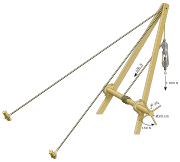 |
|
| Escapement Escapement In mechanical watches and clocks, an escapement is a device that transfers energy to the timekeeping element and enables counting the number of oscillations of the timekeeping element... |
3rd century BC | Described by the Greek Ancient Greece Ancient Greece is a civilization belonging to a period of Greek history that lasted from the Archaic period of the 8th to 6th centuries BC to the end of antiquity. Immediately following this period was the beginning of the Early Middle Ages and the Byzantine era. Included in Ancient Greece is the... engineer Philo of Byzantium Philo of Byzantium Philo of Byzantium , also known as Philo Mechanicus, was a Greek engineer and writer on mechanics, who lived during the latter half of the 3rd century BC... (3rd century BC) in his technical treatise Pneumatics (chapter 31) as part of a washstand Washstand A washstand is a table or stand containing conveniences for washing oneself.- Ancient Greece:In his Pneumatics, Philo of Byzantium, a Greek engineer and writer on mechanics, describes an escapement mechanism, the earliest known, as part of a washstand... automaton for guests washing their hands. Philon's comment that "its construction is similar to that of clocks" indicates that such escapements mechanism were already integrated in ancient water clocks. |
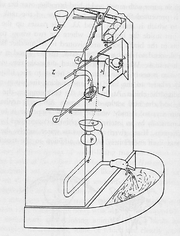 |
|
| Tumbler lock Lock (device) A lock is a mechanical or electronic fastening device that is released by a physical object or secret information , or combination of more than one of these.... |
ca. 5th c. BC | The tumbler lock, as well as other varieties, was introduced to Greece in the 5th century BC. | ||
| Gear Gear A gear is a rotating machine part having cut teeth, or cogs, which mesh with another toothed part in order to transmit torque. Two or more gears working in tandem are called a transmission and can produce a mechanical advantage through a gear ratio and thus may be considered a simple machine.... s |
ca. 5th c. BC | Developed further than in prehistoric times for a variety of practical purposes. | ||
| Plumbing Plumbing Plumbing is the system of pipes and drains installed in a building for the distribution of potable drinking water and the removal of waterborne wastes, and the skilled trade of working with pipes, tubing and plumbing fixtures in such systems. A plumber is someone who installs or repairs piping... |
ca. 5th c. BC | Excavations at Olympus as well as Athens have revealed extensive plumbing systems for baths and fountains as well as for personal use. | ||
| Spiral staircase Spiral staircase Spiral staircase may refer to:* A type of stairway characterized by its spiral shape* The Spiral Staircase , a 1946 American psychological thriller film* The Spiral Staircase , a 1975 British film, a remake of the 1946 film... |
480-470 BC | The earliest spiral staircases appear in Temple A in Selinunte Selinunte Selinunte is an ancient Greek archaeological site on the south coast of Sicily, southern Italy, between the valleys of the rivers Belice and Modione in the province of Trapani. The archaeological site contains five temples centered on an acropolis... , Sicily Sicily Sicily is a region of Italy, and is the largest island in the Mediterranean Sea. Along with the surrounding minor islands, it constitutes an autonomous region of Italy, the Regione Autonoma Siciliana Sicily has a rich and unique culture, especially with regard to the arts, music, literature,... , to both sides of the cella Cella A cella or naos , is the inner chamber of a temple in classical architecture, or a shop facing the street in domestic Roman architecture... . The temple was constructed around 480-470 BC. |
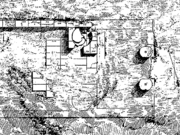 |
|
| Urban planning | ca. 5th c. BC | Miletus is one of the first known towns in the world to have a grid like plan for residential and public areas. It accomplished this feat through a variety of related innovations in areas such as surveying. | ||
| Crossbow Crossbow A crossbow is a weapon consisting of a bow mounted on a stock that shoots projectiles, often called bolts or quarrels. The medieval crossbow was called by many names, most of which derived from the word ballista, a torsion engine resembling a crossbow in appearance.Historically, crossbows played a... |
ca. 5th c. BC | The Greeks Greeks The Greeks, also known as the Hellenes , are a nation and ethnic group native to Greece, Cyprus and neighboring regions. They also form a significant diaspora, with Greek communities established around the world.... made use of a handheld crossbow called the gastraphetes Gastraphetes The gastraphetes was a hand-held crossbow used by the Ancient Greeks. It was described in the 1st century AD by the Greek author Heron of Alexandria in his work Belopoeica, which draws on an earlier account of the famous Greek engineer Ctesibius... . |
||
| Winch Winch A winch is a mechanical device that is used to pull in or let out or otherwise adjust the "tension" of a rope or wire rope . In its simplest form it consists of a spool and attached hand crank. In larger forms, winches stand at the heart of machines as diverse as tow trucks, steam shovels and... |
5th c. BC | The earliest literary reference to a winch can be found in the account of Herodotus of Halicarnassus on the Persian Wars Greco-Persian Wars The Greco-Persian Wars were a series of conflicts between the Achaemenid Empire of Persia and city-states of the Hellenic world that started in 499 BC and lasted until 449 BC. The collision between the fractious political world of the Greeks and the enormous empire of the Persians began when Cyrus... (Histories 7.36), where he describes how wooden winches were used to tighten the cables for a pontoon bridge across the Hellespont in 480 B.C. Winches may have been employed even earlier in Assyria Assyria Assyria was a Semitic Akkadian kingdom, extant as a nation state from the mid–23rd century BC to 608 BC centred on the Upper Tigris river, in northern Mesopotamia , that came to rule regional empires a number of times through history. It was named for its original capital, the ancient city of Assur... , though. By the 4th century BC, winch and pulley hoists were regarded by Aristotle Aristotle Aristotle was a Greek philosopher and polymath, a student of Plato and teacher of Alexander the Great. His writings cover many subjects, including physics, metaphysics, poetry, theater, music, logic, rhetoric, linguistics, politics, government, ethics, biology, and zoology... as common for architectural use (Mech. 18; 853b10-13). |
||
| Wheelbarrow Wheelbarrow A wheelbarrow is a small hand-propelled vehicle, usually with just one wheel, designed to be pushed and guided by a single person using two handles to the rear, or by a sail to push the ancient wheelbarrow by wind. The term "wheelbarrow" is made of two words: "wheel" and "barrow." "Barrow" is a... |
5th c. BC | Two building material inventories for 408/407 and 407/406 B.C. from the temple of Eleusis list, among other machines and tools, a one-wheeler (hyperteria monokyklou). | ||
| Showers | 4th c. BC | A shower room for female athletes with plumbed-in water is depicted on an Athenian vase. A whole complex of shower-baths was also found in a 2nd century BC gymnasium Gymnasium (ancient Greece) The gymnasium in ancient Greece functioned as a training facility for competitors in public games. It was also a place for socializing and engaging in intellectual pursuits. The name comes from the Ancient Greek term gymnós meaning "naked". Athletes competed in the nude, a practice said to... at Pergamum. |
||
| Central heating Central heating A central heating system provides warmth to the whole interior of a building from one point to multiple rooms. When combined with other systems in order to control the building climate, the whole system may be a HVAC system.Central heating differs from local heating in that the heat generation... |
ca. 350 BC | Great Temple of Ephesus was warmed by heated air that was circulated through flues laid in the floor. | ||
| Lead sheathing | ca. 350 BC | To protect a ships hull from boring creatures. see Kyrenia ship Kyrenia ship The Kyrenia ship is the wreck of a 4th century BC Greek merchant ship. It was discovered by Greek-Cypriot diving instructor Andreas Cariolou in November 1965 during a storm. Having lost the exact position Cariolou carried out more than 200 dives until he re-discovered the wreck in 1967 close to... |
||
| Astrolabe Astrolabe An astrolabe is an elaborate inclinometer, historically used by astronomers, navigators, and astrologers. Its many uses include locating and predicting the positions of the Sun, Moon, planets, and stars, determining local time given local latitude and longitude, surveying, triangulation, and to... |
ca. 300 BC | First used around 200 B.C. by astronomers in Greece. Used to determine the altitude of objects in the sky. | ||
| Canal lock Lock (water transport) A lock is a device for raising and lowering boats between stretches of water of different levels on river and canal waterways. The distinguishing feature of a lock is a fixed chamber in which the water level can be varied; whereas in a caisson lock, a boat lift, or on a canal inclined plane, it is... |
early 3rd c. BC | Built into Ancient Suez Canal under Ptolemy II (283–246 BC) | ||
| Ancient Suez Canal | early 3rd c. BC | Opened by Greek engineers under Ptolemy II (283–246 BC), following earlier, probably only partly successful attempts | ||
| Lighthouse Lighthouse A lighthouse is a tower, building, or other type of structure designed to emit light from a system of lamps and lenses or, in older times, from a fire, and used as an aid to navigation for maritime pilots at sea or on inland waterways.... |
ca. 3rd c. BC | The Lighthouse of Alexandria Lighthouse of Alexandria The Lighthouse of Alexandria, also known as the Pharos of Alexandria , was a tower built between 280 and 247 BC on the island of Pharos at Alexandria, Egypt... was designed and constructed by Sostratus of Cnidus Sostratus of Cnidus Sostratus of Cnidus , was a Greek architect and engineer. He designed the lighthouse of Alexandria, one of the Seven Wonders of the World , on the island of Pharos off Alexandria, Egypt.-External links:*... . |
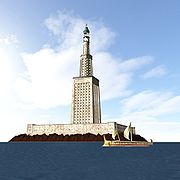 |
|
| Water wheel Water wheel A water wheel is a machine for converting the energy of free-flowing or falling water into useful forms of power. A water wheel consists of a large wooden or metal wheel, with a number of blades or buckets arranged on the outside rim forming the driving surface... |
3rd c. BC | First described by Philo of Byzantium Philo of Byzantium Philo of Byzantium , also known as Philo Mechanicus, was a Greek engineer and writer on mechanics, who lived during the latter half of the 3rd century BC... (ca. 280–220 BC) |
||
| Alarm clock Alarm clock An alarm clock is a clock that is designed to make a loud sound at a specific time. The primary use of these clocks is to awaken people from their night's sleep or short naps; they are sometimes used for other reminders as well. To stop the sound, a button or handle on the clock is pressed; but... |
3rd c. BC | The Hellenistic engineer and inventor Ctesibius Ctesibius Ctesibius or Ktesibios or Tesibius was a Greek inventor and mathematician in Alexandria, Ptolemaic Egypt. He wrote the first treatises on the science of compressed air and its uses in pumps... (fl. Floruit Floruit , abbreviated fl. , is a Latin verb meaning "flourished", denoting the period of time during which something was active... 285–222 BC) fitted his clepsydra Water clock A water clock or clepsydra is any timepiece in which time is measured by the regulated flow of liquid into or out from a vessel where the amount is then measured.Water clocks, along with sundials, are likely to be the oldest time-measuring instruments, with the only exceptions... s with dial and pointer for indicating the time, and added elaborate "alarm systems, which could be made to drop pebbles on a gong, or blow trumpets (by forcing bell-jars down into water and taking the compressed air through a beating reed) at pre-set times" (Vitruv 11.11). |
||
| Odometer Odometer An odometer or odograph is an instrument that indicates distance traveled by a vehicle, such as a bicycle or automobile. The device may be electronic, mechanical, or a combination of the two. The word derives from the Greek words hodós and métron... |
ca. 3rd c. BC | Odometer, a device used in the late Hellenistic time and by Romans for indicating distance traveled by a vehicle was invented sometime in the 3rd century BC. Some historians attribute it to Archimedes Archimedes Archimedes of Syracuse was a Greek mathematician, physicist, engineer, inventor, and astronomer. Although few details of his life are known, he is regarded as one of the leading scientists in classical antiquity. Among his advances in physics are the foundations of hydrostatics, statics and an... , others to Hero of Alexandria Hero of Alexandria Hero of Alexandria was an ancient Greek mathematician and engineerEnc. Britannica 2007, "Heron of Alexandria" who was active in his native city of Alexandria, Roman Egypt... . It helped revolutionize the building of roads and travelling by them by accurately measuring distance and being able to illustrate this with a milestone. |
||
| Chain drive Chain drive Chain drive is a way of transmitting mechanical power from one place to another. It is often used to convey power to the wheels of a vehicle, particularly bicycles and motorcycles... |
3rd c. BC | First described by Philo of Byzantium Philo of Byzantium Philo of Byzantium , also known as Philo Mechanicus, was a Greek engineer and writer on mechanics, who lived during the latter half of the 3rd century BC... . The device powered a repeating crossbow Repeating crossbow A repeating crossbow is a crossbow where the separate actions of stringing the bow, placing the bolt and shooting it can be accomplished with a simple one-handed movement while keeping the crossbow stationary. This allows a higher rate of fire than a normal crossbow... , the first known of its kind. |
||
| Cannon Cannon A cannon is any piece of artillery that uses gunpowder or other usually explosive-based propellents to launch a projectile. Cannon vary in caliber, range, mobility, rate of fire, angle of fire, and firepower; different forms of cannon combine and balance these attributes in varying degrees,... |
ca. 3rd c. BC | Ctesibius Ctesibius Ctesibius or Ktesibios or Tesibius was a Greek inventor and mathematician in Alexandria, Ptolemaic Egypt. He wrote the first treatises on the science of compressed air and its uses in pumps... of Alexandria invented a primitive form of the cannon, operated by compressed air. |
||
| Double-action principle | 3rd c. BC | Universal mechanical principle which was discovered and applied first by the engineer Ctesibius in his double action piston pump which later was developed further by Heron to a fire hose Fire hose A fire hose is a high-pressure hose used to carry water or other fire retardant to a fire to extinguish it. Outdoors, it is attached either to a fire engine or a fire hydrant. Indoors, it can be permanently attached to a building's standpipe or plumbing system... (see below). |
||
| Levers | ca. 260 BC | First described about 260 BC by the ancient Greek mathematician Archimedes. Although used in prehistoric times, they were first put to practical use for more developed technologies in Ancient Greece. | ||
| Water mill | ca. 250 BC | The use of water power was pioneered by the Greeks: The earliest mention of a water mill in history occurs in Philo's Philo of Byzantium Philo of Byzantium , also known as Philo Mechanicus, was a Greek engineer and writer on mechanics, who lived during the latter half of the 3rd century BC... Pneumatics, previously been regarded as a later Arabic interpolation, but according to recent research to be of authentic Greek origin. |
||
| Three-masted Mast (sailing) The mast of a sailing vessel is a tall, vertical, or near vertical, spar, or arrangement of spars, which supports the sails. Large ships have several masts, with the size and configuration depending on the style of ship... ship (mizzen) |
c. 240 BC: | First recorded for Syracusia Syracusia Syracusia was a ancient Greek ship sometimes claimed to be the largest transport ship of antiquity. It only sailed once, from Syracuse in Sicily to Alexandria in the Ptolemaic Kingdom.-General characteristics:... as well as other Syracusan (merchant) ships under Hiero II of Syracuse Hiero II of Syracuse Hieron II , king of Syracuse from 270 to 215 BC, was the illegitimate son of a Syracusan noble, Hierocles, who claimed descent from Gelon. He was a former general of Pyrrhus of Epirus and an important figure of the First Punic War.... |
||
| Gimbal Gimbal A gimbal is a pivoted support that allows the rotation of an object about a single axis. A set of two gimbals, one mounted on the other with pivot axes orthogonal, may be used to allow an object mounted on the innermost gimbal to remain immobile regardless of the motion of its support... |
3rd c. BC | The inventor Philo of Byzantium Philo of Byzantium Philo of Byzantium , also known as Philo Mechanicus, was a Greek engineer and writer on mechanics, who lived during the latter half of the 3rd century BC... (280-220 BC) described an eight-sided ink Ink Ink is a liquid or paste that contains pigments and/or dyes and is used to color a surface to produce an image, text, or design. Ink is used for drawing and/or writing with a pen, brush, or quill... pot with an opening on each side, which can be turned so that any face is on top, dip in a pen and ink it-yet the ink never runs out through the holes of the side. This was done by the suspension of the inkwell at the center, which was mounted on a series of concentric metal rings which remained stationary no matter which way the pot turns itself. |
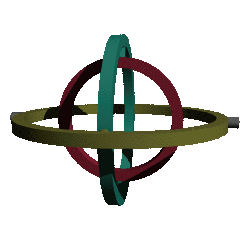 |
|
| Dry dock Dry dock A drydock is a narrow basin or vessel that can be flooded to allow a load to be floated in, then drained to allow that load to come to rest on a dry platform... |
ca. 200 BC | Invented in Ptolemaic Egypt Ptolemaic Egypt Ptolemaic Egypt began when Ptolemy I Soter invaded Egypt and declared himself Pharaoh of Egypt in 305 BC and ended with the death of queen Cleopatra VII of Egypt and the Roman conquest in 30 BC. The Ptolemaic Kingdom was a powerful Hellenistic state, extending from southern Syria in the east, to... some time after the death of Ptolemy IV Philopator Ptolemy IV Philopator Ptolemy IV Philopator , son of Ptolemy III and Berenice II of Egypt was the fourth Pharaoh of Ptolemaic Egypt... (reigned 221-204 BC) as recorded by Athenaeus of Naucratis. |
||
| Fore-and-aft rig Fore-and-aft rig A fore-and-aft rig is a sailing rig consisting mainly of sails that are set along the line of the keel rather than perpendicular to it. Such sails are described as fore-and-aft rigged.... (spritsail Spritsail The spritsail is a form of three or four-sided, fore-aft sail and its rig. Unlike the gaff where the head hangs from a spar along its edge, this rig supports the leech of the sail by means of a spar or spars named a sprit... ) |
2nd c. BC | Spritsails, the earliest fore-and-aft rigs, appeared in the 2nd c. BC in the Aegean Sea Aegean Sea The Aegean Sea[p] is an elongated embayment of the Mediterranean Sea located between the southern Balkan and Anatolian peninsulas, i.e., between the mainlands of Greece and Turkey. In the north, it is connected to the Marmara Sea and Black Sea by the Dardanelles and Bosporus... on small Greek craft. |
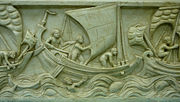 |
|
| Air and water pumps Hydraulics Hydraulics is a topic in applied science and engineering dealing with the mechanical properties of liquids. Fluid mechanics provides the theoretical foundation for hydraulics, which focuses on the engineering uses of fluid properties. In fluid power, hydraulics is used for the generation, control,... |
ca. 2nd c. BC | Ctesibius and various other Greeks of Alexandria of the period developed and put to practical use various air and water pumps which served a variety of purposes, such as a water organ. | ||
| Sakia Sakia A sakia , tympanum or tablia is a water wheel, somewhat similar to a noria, and used primarily in Egypt. It is a large hollow wheel, normally made of galvanized sheet steel, with scoops or buckets at the periphery... gear |
2nd c. BC | First appeared in 2nd BC Hellenistic Egypt where pictorial evidence already showed it fully developed | ||
| Surveying tools Surveying See Also: Public Land Survey SystemSurveying or land surveying is the technique, profession, and science of accurately determining the terrestrial or three-dimensional position of points and the distances and angles between them... |
ca. 2nd c. BC | Various records relating to mentions of surveying tools have been discovered, mostly in Alexandrian sources, these greatly helped the development of the precision of Roman Aqueducts. | ||
| Analog computers | ca. 150 BC | See Antikythera mechanism Antikythera mechanism The Antikythera mechanism is an ancient mechanical computer designed to calculate astronomical positions. It was recovered in 1900–1901 from the Antikythera wreck. Its significance and complexity were not understood until decades later. Its time of construction is now estimated between 150 and 100... |
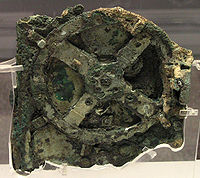 |
|
| Fire hose Fire hose A fire hose is a high-pressure hose used to carry water or other fire retardant to a fire to extinguish it. Outdoors, it is attached either to a fire engine or a fire hydrant. Indoors, it can be permanently attached to a building's standpipe or plumbing system... |
1st c. BC | Invented by Hero in the basis of Ctesibius' double action piston pump. Allowed for more efficient fire fighting. | ||
| Vending machine Vending machine A vending machine is a machine which dispenses items such as snacks, beverages, alcohol, cigarettes, lottery tickets, consumer products and even gold and gems to customers automatically, after the customer inserts currency or credit into the machine.... |
1st c. BC | The first vending machine was described by Hero of Alexandria Hero of Alexandria Hero of Alexandria was an ancient Greek mathematician and engineerEnc. Britannica 2007, "Heron of Alexandria" who was active in his native city of Alexandria, Roman Egypt... . His machine accepted a coin and then dispensed a fixed amount of holy water Holy water Holy water is water that, in Catholicism, Anglicanism, Eastern Orthodoxy, Lutheranism, Oriental Orthodoxy, and some other churches, has been sanctified by a priest for the purpose of baptism, the blessing of persons, places, and objects; or as a means of repelling evil.The use for baptism and... . When the coin was deposited, it fell upon a pan attached to a lever. The lever opened up a valve which let some water flow out. The pan continued to tilt with the weight of the coin until it fell off, at which point a counter-weight would snap the lever back up and turn off the valve. |
||
| Wind vane | 50 BC | The Tower of the Winds Tower of the Winds The Tower of the Winds, also called horologion , is an octagonal Pentelic marble clocktower on the Roman agora in Athens. The structure features a combination of sundials, a water clock and a wind vane... on the Roman Ancient Rome Ancient Rome was a thriving civilization that grew on the Italian Peninsula as early as the 8th century BC. Located along the Mediterranean Sea and centered on the city of Rome, it expanded to one of the largest empires in the ancient world.... agora Agora The Agora was an open "place of assembly" in ancient Greek city-states. Early in Greek history , free-born male land-owners who were citizens would gather in the Agora for military duty or to hear statements of the ruling king or council. Later, the Agora also served as a marketplace where... in Athens Athens Athens , is the capital and largest city of Greece. Athens dominates the Attica region and is one of the world's oldest cities, as its recorded history spans around 3,400 years. Classical Athens was a powerful city-state... featured atop a wind vane in the form of a bronze Triton Triton (mythology) Triton is a mythological Greek god, the messenger of the big sea. He is the son of Poseidon, god of the sea, and Amphitrite, goddess of the sea, whose herald he is... holding a rod in his outstretched hand rotating to the wind blowing. Below, its frieze Frieze thumb|267px|Frieze of the [[Tower of the Winds]], AthensIn architecture the frieze is the wide central section part of an entablature and may be plain in the Ionic or Doric order, or decorated with bas-reliefs. Even when neither columns nor pilasters are expressed, on an astylar wall it lies upon... was adorned with the eight wind deities. The 8 m high structure also featured sundial Sundial A sundial is a device that measures time by the position of the Sun. In common designs such as the horizontal sundial, the sun casts a shadow from its style onto a surface marked with lines indicating the hours of the day. The style is the time-telling edge of the gnomon, often a thin rod or a... s and a water clock Water clock A water clock or clepsydra is any timepiece in which time is measured by the regulated flow of liquid into or out from a vessel where the amount is then measured.Water clocks, along with sundials, are likely to be the oldest time-measuring instruments, with the only exceptions... inside dates from around 50 BC. |
||
| Clock tower Clock tower A clock tower is a tower specifically built with one or more clock faces. Clock towers can be either freestanding or part of a church or municipal building such as a town hall. Some clock towers are not true clock towers having had their clock faces added to an already existing building... |
50 BC See Clock Tower. |
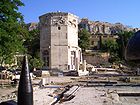 |
||
| Automatic doors Door A door is a movable structure used to open and close off an entrance, typically consisting of a panel that swings on hinges or that slides or rotates inside of a space.... |
ca. 1st c. AD | Hero of Alexandria Hero of Alexandria Hero of Alexandria was an ancient Greek mathematician and engineerEnc. Britannica 2007, "Heron of Alexandria" who was active in his native city of Alexandria, Roman Egypt... , a 1st century BC inventor from Alexandria Alexandria Alexandria is the second-largest city of Egypt, with a population of 4.1 million, extending about along the coast of the Mediterranean Sea in the north central part of the country; it is also the largest city lying directly on the Mediterranean coast. It is Egypt's largest seaport, serving... , Egypt Egypt Egypt , officially the Arab Republic of Egypt, Arabic: , is a country mainly in North Africa, with the Sinai Peninsula forming a land bridge in Southwest Asia. Egypt is thus a transcontinental country, and a major power in Africa, the Mediterranean Basin, the Middle East and the Muslim world... , created automatic doors for a temple with the aid of steam power. |
See also
- Roman technologyRoman technologyRoman technology is the engineering practice which supported Roman civilization and made the expansion of Roman commerce and Roman military possible over nearly a thousand years....
- History of science in Classical AntiquityHistory of science in Classical AntiquityThe history of science in classical antiquity encompasses both those inquiries into the workings of the universe aimed at such practical goals as establishing a reliable calendar or determining how to cure a variety of illnesses and those abstract investigations known as natural philosophy...
- Medieval technologyMedieval technologyMedieval technology refers to the technology used in medieval Europe under Christian rule. After the Renaissance of the 12th century, medieval Europe saw a radical change in the rate of new inventions, innovations in the ways of managing traditional means of production, and economic growth...
- Science in Medieval Western Europe
- List of Byzantine inventions
Further reading
- Lewis, M. J. T., "Railways in the Greek and Roman world", in Guy, A. / Rees, J. (eds), Early Railways. A Selection of Papers from the First International Early Railways Conference (2001), pp. 8–19 (10-15)
- Kotsanas, Kosatas (2009) -"familiar and unfamiliar aspects of Ancient Greek Technology" (ISBN 978-9963-9270-2-9)
- Kotsanas, Kosatas (2008) -"Ancient Greek Technology" (ISBN 978-960-930859-5)

